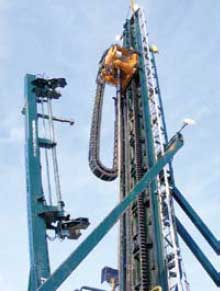The American Augers engineering concept was to create a drilling rig that used a rack-and-pinion design, which mechanically allows the rig to increase its performance since the drilling rig would use rack-and-pinion thrust, rather than gravity, to load the drillbit.
The company used rack-and-pinion on the drilling rig because it was the technology they had employed successfully in Horizontal Directional Drilling (HDD) equipment, Fig. 1. A rack and pinion system provides smoother movement of the top head drive, which leads to more efficient operating control of the entire unit, and prolongs the mechanical life of the system.
 |
|
Fig. 1. American Auger’s prototype rack and pinion rig.
|
|
In November 2007, the first American Augers oil/gas rig, VR-330, was put into service in Louisville, Ohio. The drill rig was purchased by Akerman Construction from Purcell, Oklahoma.
The Akerman crew began the drill rig setup process, and completed that task in a roughly 10 hr. This was done in minimal time because the rig was developed as a self-contained, multi-component unit on a 23-m-long, quad-axle trailer that houses the drill derrick. The drill rig is positioned atop a steel constructed base, a “mud boat.” It’s primary job is to allow the drill rig to gain more working height for the Blow Out Preventer (BOP). A working platform is then fixed to the operating end of the drill rig, which creates a work space with access to the wrench, top head drive, and derrick, but also is the ground operating space for positioning of BOP and drilling activity.
Once preparations were completed, the crew set up the dual-axle power trailer, which has two 365 hp (272 kW) Caterpillar Tier III diesel engines. The power trailer is connected by cables to the rig creating a self-powered system. In addition to the power trailer, a hydraulic pipe-handling system is aligned on the rig’s operating side. The pipe handler has a vertical working height of 14 m, which allows the drill crew to conduct an exchange of drill pipe from the side-mounted pipe racks to the top head drive. The crew powers the pipe handler with cabling connected to the drill rig’s hydraulic system.
Completing the setup allowed the derrick to be raised to its vertical working height of 23.5 m, which is done by rear-mounted, dual-hydraulic, telescoping lift cylinders and dual fixed struts, which secure the rig in the upright position.
The balance of the drill site set up was complete in around 36 hr. Once the drill process began the drill crew was able to take full advantage of the rig, which permitted the operator to apply optimum bit load upon surface contact. The hole that the rig was creating was drilled down to 1,433 m TVD.
The drill crew began to make a horizontal bend at around 1,250 m.
The driller pushed the drill pipe out horizontally an additional 671 m.
As the original rig completed its hole, the second and third rigs were purchased, and delivered to Akerman Construction in April 2008 and May 2008, respectively. The third rig was commissioned to drill the Marcellus Shale.
One advantage of the rig is that it can also be employed for vertical drilling. After the completion of a well in Troy, Pennsylvania the rig was used in Penfield, Pennsylvania, and completed a vertical natural gas well to 2,072 m TMD.
Safety is gained because the rig does not require drill crew members to be present on the drilling floor as in traditional drilling applications.
Another available option was to engage the Wiggle Steer technology that allows the drill operator to rotate the drill pipe and the cutting drillstring head back and forth over a predetermined range. This motion causes the hole to be more open in a particular direction and facilitates steering the drilling pipe.
The rig’s success was not isolated to the northern US. The second rig then went on to drill two adjacent 671-m natural gas wells in Copperas Cove, Texas, and then returned to Gatesville, Texas for an additional 1,219-m natural gas well. To date, the second rig has been responsible for 11 natural gas wells.
In late 2008, the company will launch the brand new VR-500 vertical drilling rig. This new rig will improve the hook load capacity to 250 tonnes, and boost the engine output to 1,400 hp. Increased rotary torque will permit a maximum yield of 30,000 ft-lbs (40,500 Nm). 
|



